History of Delhi
Delhi has a long history, and has been an important political centre of India as the capital of several empires.[1] Much of Delhi's ancient history finds no record and this may be regarded as a lost period of its history. Extensive coverage of Delhi's history begins with the onset of the Delhi Sultanate in the 12th century. Since then, Delhi has been the centre of a succession of mighty empires and powerful kingdoms, making Delhi one of the longest-serving capitals and one of the oldest inhabited cities in the world. It is considered to be a city built, destroyed and rebuilt several times, as outsiders who successfully invaded the Indian Subcontinent would ransack the existing capital city in Delhi, and those who came to conquer and stay would be so impressed by the city's strategic location as to make it their capital and rebuild it in their own way.[2][3]
| Historical Region of North India Delhi | |||||||||
 | |||||||||
| Location | Delhi | ||||||||
| State established: | 736 CE | ||||||||
| Language | Hindustani (Hindi and Urdu), Punjabi, Bengali, English | ||||||||
| Dynasties |
| ||||||||
The Delhi Sultanate is the name given for a series of five successive dynasties, which remained as a dominant power of Indian subcontinent with Delhi as their capital. The rule of the Delhi Sultanate was established in 1206 by Qutub-ud-Din Aibak. The relics of the Delhi Sultanate include the Qutb Minar and its surrounding monuments and the Tughlaqabad Fort.[4] During this time, the city became a center for culture.[5] The Delhi Sultanate came to an end in 1526, when Babur defeated the forces of the last sultan of Delhi, Ibrahim Lodi at the first Battle of Panipat, and formed the Mughal Empire.
The Mughal Empire ruled the area for three centuries. During the 16th century, the city declined as the Mughal capital was shifted. The fifth Mughal Emperor Shah Jahan built the walled city of Shahjahanabad within Delhi, and its landmarks, the Red Fort and Jama Masjid.[6][7] His reign would be considered the zenith of the empire. After the death of his successor Aurangzeb, the Mughal Empire was plagued by a series of revolts. They lost major portions to the Maratha and Sikh empires, and Delhi was sacked and looted by Nader Shah. In 1803, the Delhi was captured by the British East India Company.
During Company Rule in India, the Mughal Emperor Bahadur Shah II was reduced to merely a figurehead. The Indian Rebellion of 1857 sought to end company rule and declared Bahadur Shah II the Emperor of India. However, the British soon recaptured Delhi and their other territories, ending the short-lived rebellion. This also marked the beginning of direct British Rule in India. In 1911, the capital of British India was shifted from Calcutta to New Delhi, the last inner city of Delhi designed by Edwin Lutyens.
After India's Independence from the British, New Delhi became the capital of the newly formed Republic of India.
Cities of Delhi
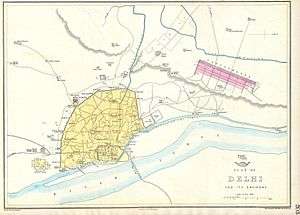
It is popularly said that Delhi was the site for a total of seven different cities through the ages. The phrase of the seven cities of Delhi was coined by colonial-era historians and originally referred only to the Islamic era settlements, i.e. the sites of the sultanate and Mughal rulers.[8] Hence, the classic list of the seven cities of Delhi includes the following sites:
- Qutb Minar complex/Mehrauli, the site of the first capital of the Delhi Sultanate, mostly developed during the rule of the Mamluk (Slave) dynasty between 1192 and 1290, who strengthened the defences of the pre-existing forts known as Lalkot and Qila Rai Pithora and constructed new buildings within their boundaries.[9]
- Siri, first established as a camp for protection against invading Mongols by Alauddin Khalji, and fortified in about ca. 1303 A.D.[10]
- Tughlaqabad, built by Ghiyasuddin Tughluq in ca. 1320 A.D.[11]
- Jahanpanah, literally Sanctuary of the World, created by the construction of two long walls connecting the first two Delhis (Qutb Minar complex/Mehrauli and Siri), built by Muhammad bin Tughluq in ca. 1325 A.D.[12]
- Ferozabad, built by Firuz Shah Tughluq in ca. 1354 A.D.[13]
- Dinpanah, literally Sanctuary of the Faith, built by Humayun, and Shergarh, built by Sher Shah Suri, both in the area near the speculated site of the legendary Indraprastha (1538–1545).[14]
- Shahjahanabad, the walled city built by Shah Jahan from 1638 to 1649, containing the Lal Qila and the Chandni Chowk, nowadays known as Old Delhi.[15]
However, this classic list doesn't take into account numerous other settlements, established before, during and after the Islamic rule, in the area commonly called the 'Delhi Triangle,' bounded to the south and the west by the Aravalli Range, locally known as the Delhi Ridge, and to the east by the Yamuna River.[16][17]
Among the most relevant sites are:
- Indraprastha, the legendary ancient city is believed to have been established 5000 years ago, as per the ancient Indian epic Mahabharata. A long-standing tradition associates Delhi with Indraprastha and identifies the legendary city with the village Indarpat, which survived until the early 20th century within the Purana Qila. There is no tangible archeological evidence, however, which links the excavated 'painted greyware' at Purana Qila with the Bharata Khanda site.[18]
- Surajkund (Anangpur), Tomara settlement dating from the 9th or 10th century, where a large masonry tank can be found.
- Lalkot, allegedly built ca. 1052 A.D. by the Tomara ruler Anangpal.
- Qila Rai Pithora, allegedly built in ca. 1180 A.D. by Prithviraj Chauhan, who extended and fortified the Lalkot as a defence against invaders. This area, now called Mehrauli, was then redeveloped as the seat of the Mamluk (Slave) dynasty, who built the Qutb Minar complex within its boundaries.
- Lodi Complex, built by the Sayyid and Lodi dynasties in the 15th and early 16th century.
- Lutyens' Delhi or New Delhi, the city built by the British, declared Capital on 12 December 1911. On 12 December 2011 New Delhi celebrated 100 years of serving as India's National Capital.[1][19]
Modern Delhi, i.e. the National Capital Territory, encompasses all of the above sites (the only exception is Surajkund, which is south of Delhi's administrative border to Haryana). For various reasons, modern versions of the list of the seven cities of Delhi can include a different set of settlements. Official accounts, for example, tend to count the Rajput-founded Lalkot/Qila Rai Pithora as the first city of Delhi.[20]

Early history
Significant prehistoric sites in Delhi include Anangpur (in the Badarpur region), as well as Harappan excavations near Narela and Nand Nagari.[23] References to Delhi's history in ancient literature are based on myths and legends. According to the Hindu epic Mahabharata, a city called Indraprastha, "City of the God Indra", was the capital of the Pandavas. There is a strong belief that Purana Qila was built over the site of ancient Indraprastha. Northern Black Polished Ware (c. 700-200 BCE) have been excavated at the site, and pieces of Painted Grey Ware were found on the surface, suggesting an even older settlement, possibly going back to ca. 1000 BCE.[23]
According to Indian folklore, Delhi was the site of the magnificent and opulent Indraprastha, capital of the Pandavas in the Indian epic Mahabharata, founded around 3500 BC. It was, one of the five prasthas or `plains', which included Sonepat, Panipat, Tilpat (near Faridabad), and Baghpat.[24] 16th-century, Persian historian, Firishta, recorded a tradition that Delhi or Dilli was founded by a Raja Dhilu before the Yavana (Greek) invasions. The kings then referred to the initial Muslim invaders as Yavanas.[24]
Hindu texts state that the city of Delhi used to be referred to in Sanskrit as Indraprastha, which means "city of Lord Indra". The name Delhi may be derived from the word 'Dhillika', though there are other theories. According to Satyarth Prakash (1874) of Swami Dayanand, Raja Dhilu (King Dihlu) founded ancient Delhi in 800 BCE.[25] It was the name of the first medieval township of Delhi, located on the southwestern border of the present Delhi, in Mehrauli. This was the first in the series of seven medieval cities. It is also known as Yoginipura, that is, the fortress of the Yoginis (female divinities). It gained importance during the time of Anangpal Tomar. In the 12th century, the city was included in the dominions of Prithviraj Chauhan.
Pasanaha Chariu of Vibudh Shridhar (VS 1189–1230) an Apabhramsha writer, provides the first reference to the legend of the origin of the name Dhilli for Delhi.[26]
हरियाणए देसे असंखगाम, गामियण जणि अणवरथ काम|
परचक्क विहट्टणु सिरिसंघट्टणु, जो सुरव इणा परिगणियं|
रिउ रुहिरावट्टणु बिउलु पवट्टणु, ढिल्ली नामेण जि भणियं|
Translation: There are countless villages in Haryana country. The villagers there work hard. They don't accept domination of others, and are experts in making the blood of their enemies flow. Indra himself praises this country. The capital of this country is Dhilli.
जहिं असिवर तोडिय रिउ कवालु, णरणाहु पसिद्धउ अणंगवालु ||
वलभर कम्पाविउ णायरायु, माणिणियण मणसंजनीय ||
Translation: The ruler Anangapal is famous, he can slay his enemies with his sword. The weight (of the Iron pillar) caused the Nagaraj to shake.
A VS 1383 inscription in Delhi Museum confirms the founding of Delhi by the Tomars:
देशोऽस्ति हरियानाख्यो पॄथिव्यां स्वर्गसन्निभः |
ढिल्लिकाख्या पुरी तत्र तोमरैरस्ति निर्मिता ||
Prithviraj Raso also confirms the founding by the Tomars and the legend of the loose nail:
हुं गड्डि गयौ किल्ली सज्जीव हल्लाय करी ढिल्ली सईव |
फिरि व्यास कहै सुनि अनंगराइ भवितव्य बात मेटी न जाइ ||
According to legends, the Tomar dynasty founded Lal Kot in 736. The Prithviraj Raso names the Tomar king Anangpal as the founder of Lal Kot, whose name is inscribed on Iron Pillar of Delhi at Qutb complex, ascribed to Chandra or Chandragupta II.[27] Anangpal Tomar is often described as the founder of Delhi, built the citadel some 10 kilometres from Suraj Kund. Prithviraj Chauhan expanded the fortification of Lal Kot which was came to be known as Qila Rai Pithora.
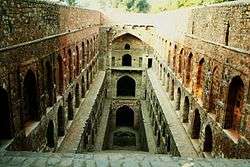
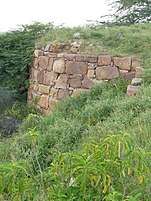 The bastion of Lal Kot fort in Delhi's Mehrauli built by Tomara ruler, Anangpal in c. 736 CE.
The bastion of Lal Kot fort in Delhi's Mehrauli built by Tomara ruler, Anangpal in c. 736 CE.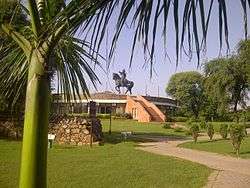 Museum and remnants of the walls at Qila Rai Pithora, the first city of Delhi, and ruled by Prithviraj Chauhan.
Museum and remnants of the walls at Qila Rai Pithora, the first city of Delhi, and ruled by Prithviraj Chauhan. Sculpture of ancient temple in Qutb Minar complex
Sculpture of ancient temple in Qutb Minar complex.jpg) Carvings of ancient temple
Carvings of ancient temple
Late Medieval period (13th-16th centuries CE)
The Chahamana (Chauhan) kings of Ajmer conquered Lal Kot in 1180 and renamed it Qila Rai Pithora. The Chauhan king Prithviraj III was defeated in 1192 by Muhammad Ghori in Second Battle of Tarain.
From 1206, Delhi became the capital of the Delhi Sultanate under the Slave Dynasty. The first Sultan of Delhi, Qutb-ud-din Aybak, was a former slave who rose through the ranks to become a general, a governor and then Sultan of Delhi. Qutb-ud-din started the construction of the Qutub Minar, a recognisable symbol of Delhi, to commemorate his victory but died before its completion. In the Qutb complex he also constructed the Quwwat-al-Islam (might of Islam), which is the earliest extant mosque in India.[4] He was said to have destroyed twenty-seven Jain temples initially housed in the Qutb complex and pillaged exquisitely carved pillars and building material from their debris for this mosque, many of which can still be seen.[29] After the end of the Slave dynasty, a succession of Turkic Central Asian and Afghan dynasties, the Khalji dynasty, the Tughluq dynasty, the Sayyid dynasty and the Lodi dynasty held power in the late medieval period and built a sequence of forts and townships in Delhi.[30][1]
The famous Iron pillar near the Qutub Minar was commissioned by the emperor Kumara Gupta I of the Gupta dynasty (320-540 CE) and transplanted to Delhi during the 10th century.
In 1398, Timur Lang invaded India on the pretext that the Muslim sultans of Delhi were too tolerant of their Hindu subjects. After defeating the armies of Nasiruddin Mahmud of Tughlaq dynasty, on 15 December 1398, Timur entered Delhi on 18 December 1398, and the city was sacked, destroyed, and left in ruins, and over 100,000 war prisoners were killed as well.[31][32] In 1526, following the First Battle of Panipat, Zahiruddin Babur, the former ruler of Fergana, defeated the last Afghan Lodi sultan and founded the Mughal dynasty which ruled from Delhi, Agra and Lahore.
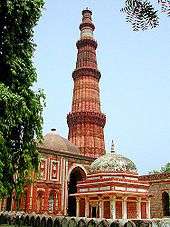
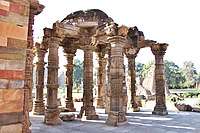 Mosque tomb over ancient temple structure in Qutb Minar complex
Mosque tomb over ancient temple structure in Qutb Minar complex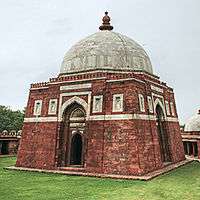 Tomb of Ghiyasuddin Tughluq within the Tughlaqabad Fort.
Tomb of Ghiyasuddin Tughluq within the Tughlaqabad Fort. Jahaz Mahal is built during the Lodi dynasty period (1452–1526) as a pleasure resort.
Jahaz Mahal is built during the Lodi dynasty period (1452–1526) as a pleasure resort.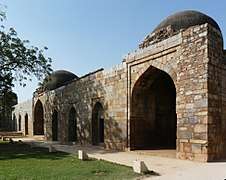 Alauddin Khilji's madrasa and Tomb in the Qutb complex.
Alauddin Khilji's madrasa and Tomb in the Qutb complex.
Early Modern period (16th-18th centuries CE)
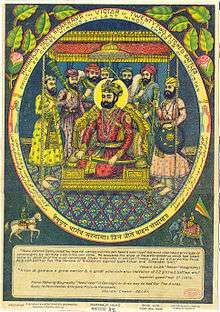
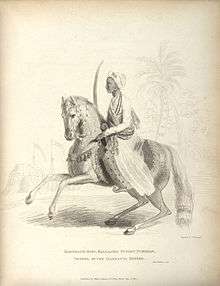 Raghunath Rao, the Maratha Peshwa who played a key role in capturing Delhi from the Afghans in the Second Battle of Delhi.
Raghunath Rao, the Maratha Peshwa who played a key role in capturing Delhi from the Afghans in the Second Battle of Delhi.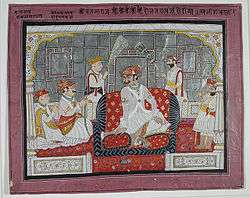 After losing the Battle of Delhi (1803) to the British, under Maratha ruler Daulat Rao Scindia, the Marathas lost control of Delhi and the right to collect chauth from the Mughals.
After losing the Battle of Delhi (1803) to the British, under Maratha ruler Daulat Rao Scindia, the Marathas lost control of Delhi and the right to collect chauth from the Mughals.
The early modern period in Indian history is marked with the rise of the Mughal Empire between the 16th and 18th centuries. After the fall of the Delhi Sultanate, the Mughals ruled from Agra, Sikri and Lahore, but the city once became the capital in 1648 during the rule of Shah Jahan, and remained the capital until the fall of the empire. During this time, Delhi became a center for culture, and poets such as Ghalib, Dard, Dagh and Zauq lived in the city and sought patronage of the emperor. The Mughals also built several monuments in the city including Humayun's Tomb, Red Fort, and Jama Masjid.
Babur and Humayun (1526–1556)
The first Mughal Emperors Babur and Humayun ruled from Agra, unlike the preceding Delhi Sultanate.
In the mid-16th century there was an interruption in the Mughal rule of India as Sher Shah Suri defeated Humayun and forced him to flee to Persia. Sher Shah Suri built the sixth city of Delhi, as well as the old fort known as Purana Qila, even though this city was settled since the ancient era. After Sher Shah Suri's death in 1545, his son Islam Shah took the reins of north India from Delhi. Islam Shah ruled from Delhi till 1553 when Hindu king Hemu, became the Prime Minister and Chief of Army of Adil Shah. Hemu fought and won 22 battles in all against rebels and twice against Akbar's army in Agra and Delhi, without losing any. After defeating Akbar's army on 7 October 1556 at Tughlaqabad fort area in Battle of Delhi (1556), Hemu acceded to Delhi throne and established Hindu Raj in North India for a brief period, and was bestowed with the title 'Vikramaditya', at his coronation in Purana Quila, Delhi. Hemu was defeated at the second battle of Panipat by Mughal forces led by Akbar's regent Bairam Khan, thus reinstating Mughal rule in the region.
Akbar to Aurangzeb (1556–1707)
The third and greatest Mughal emperor, Akbar, continued to ruled from Agra, resulting in a decline in the fortunes of Delhi. In the mid-17th century, the Mughal Emperor Shah Jahan (1628–1658) built the city that sometimes bears his name Shahjahanabad, the seventh city of Delhi that is more commonly known as the old city or old Delhi.[1][7] This city contains a number of significant architectural features, including the Red Fort (Lal Qila) and the Jama Masjid.[6] The old city served as the capital of the later Mughal Empire from 1638 onward, when Shah Jahan transferred the capital back from Agra.
Aurangzeb (1658–1707) crowned himself as emperor in Delhi in 1658 at the Shalimar garden ('Aizzabad-Bagh) with a second coronation in 1659. After 1680, the Mughal Empire's influence declined rapidly as the Hindu Maratha Empire rose to prominence.[34]
Decline of Mughal Empire (1707–1857)
In 1737, Bajirao I marched towards Delhi with a huge army. The Marathas defeated the Mughals in the First Battle of Delhi.[35][36] The Maratha forces sacked Delhi following their victory against the Mughals. In 1739, the Mughal Empire lost the huge Battle of Karnal in less than three hours against the numerically outnumbered but military superior Persian army led by Nader Shah during his invasion after which he completely sacked and looted Delhi, the Mughal capital, followed by massacre for 2 days, killing over 30,000 civilians and carrying away immense wealth including the Peacock Throne, the Daria-i-Noor, and Koh-i-Noor. Nader eventually agreed to leave the city and India after forcing the Mughal emperor Muhammad Shah I to beg him for mercy and granting him the keys of the city and the royal treasury.[37] A treaty signed in 1752 made Marathas the protector of the Mughal throne at Delhi.[38]
Ahmad Shah Durrani invaded North India for the fourth time in early 1757. He entered Delhi in January 1757 and kept the Mughal emperor under arrest. In August 1757, the Marathas once again attacked Delhi, decisively defeating Najib-ud-Daula and his Rohilla Afghan army in the Second Battle of Delhi.[39] Thus, the Marathas established full control over the city.
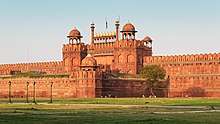 The Red Fort was commissioned by Mughal Emperor Shah Jahan in the 17th century,[6] it was the main residence of the Mughal emperors for nearly 200 years.
The Red Fort was commissioned by Mughal Emperor Shah Jahan in the 17th century,[6] it was the main residence of the Mughal emperors for nearly 200 years.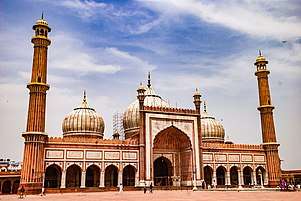 The Jama Masjid is one of the largest mosques in India.
The Jama Masjid is one of the largest mosques in India. Safdarjung's Tomb was built in 1754 in the late Mughal architectural style for Nawab Safdarjung.
Safdarjung's Tomb was built in 1754 in the late Mughal architectural style for Nawab Safdarjung.
Colonial period (19th-20th centuries CE)
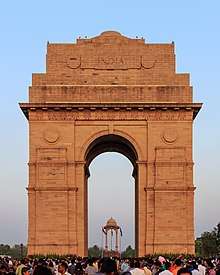
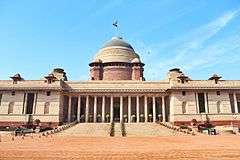
Company Rule
In 1803, during the Second Anglo-Maratha War, the forces of British East India Company defeated the Maratha forces in the Third Battle of Delhi, ending the Maratha rule over the city.[41] As a result, Delhi came under the control of British East India Company, and became a part of the North-Western Provinces. The Mughal Emperor Shah Alam II was a ruler only in name, and did not rule over any territory.
Revolt of 1857
The Indian Rebellion of 1857 sought to end Company Rule in India. On 11 May, the mutineers reached and captured Delhi, and declared Bahadur Shah II the Emperor of India, and the Emperor held his first court in many years. However, the British returned and laid siege to Delhi on 8 June 1857. On 21 September, Delhi had fallen to the British. . The city received significant damage during the battle. Afterwards, the last titular Mughal Emperor Bahadur Shah Zafar II was captured and exiled to Rangoon.
Delhi passed into the direct control of British Government in 1857 after the Indian Rebellion of 1857 and the remaining Mughal territories were annexed as a part of British India.
British Raj
Calcutta was declared the capital of British India but in 1911 at the Delhi Durbar of 1911, held at the Coronation Park, King George V announced the shifting of the capital back to Delhi. Parts of the old city were New Delhi, a monumental new quarter of the city designed by the British architect Edwin Lutyens to house the government buildings was inaugurated in 1931 after its construction was delayed due to World War I.[1][42] The University of Delhi was also founded in 1922. New Delhi was officially declared as the seat of the Government of India after independence in 1947.
Post-Independence (1947–present)
After 1967 relations between Hidus and Muslims deteriorated to the level that there was a significant uptick in the number of riots and other disruption of civil life. One of the most significant was the 1973 riot in Bao Hindu Rao area, which resulted in the injury of 18 police officers and financial losses estimated to be around 500,000 Rupees, according to police sources. The riot was started after rumors spread that local Muslims wanted to change Bao Rao to a Muslim-only area. Another significant riot happened on May 5, 1974 in the Sadar Bazar area. A row started by a Hindu family and a couple of muslims in a local cinema escalated into a clash between Hindus and Muslims in which 11 people were killed and 92 were injured. This riot was the worst in Delhi since independence. The Centre for the Study of Developing Societies carried out a survey in nearby areas that showed significant division between Hindus and Muslims who saw each other negatively.[43]
In 1966, an inscription of the Mauryan Emperor Ashoka (273-236 BCE) was discovered near Sriniwaspuri. Two sandstone pillars inscribed with the edicts of Ashoka were brought to by Firuz Shah Tughluq in the 14th century.
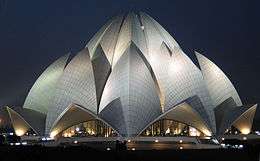 The Lotus Temple[44]
The Lotus Temple[44] Delhi today.
Delhi today.- The Raj Ghat, where Mahatma Gandhi was cremated.
See also
- Agrasen ki Baoli
- Gates of Delhi
- Mehrauli Archaeological Park
References
- Centre, UNESCO World Heritage. "Delhi – A Heritage City". UNESCO World Heritage Centre. Archived from the original on 24 April 2018. Retrieved 11 December 2018.
- "Archived copy". Archived from the original on 2 April 2015. Retrieved 10 June 2012.CS1 maint: archived copy as title (link)
- "Delhi Tourism".
- Centre, UNESCO World Heritage. "Qutb Minar and its Monuments, Delhi". UNESCO World Heritage Centre. Retrieved 11 December 2018.
- Hearn, The Seven Cities of Delhi 1906, pp. 88-99.
- Centre, UNESCO World Heritage. "Red Fort Complex". UNESCO World Heritage Centre. Archived from the original on 4 July 2018. Retrieved 11 December 2018.
- Hearn, The Seven Cities of Delhi 1906, pp. 134-173.
- Tillotson, Giles (2019). Delhi Darshan. Penguin Random House India. p. 8. ISBN 9780670091911.
- Tillotson, Giles (2019). Delhi Darshan. Penguin Random House India. pp. 8–23. ISBN 9780670091911.
- Tillotson, Giles (2019). Delhi Darshan. Penguin Random House India. pp. 25–26. ISBN 9780670091911.
- Tillotson, Giles (2019). Delhi Darshan. Penguin Random House India. p. 29. ISBN 9780670091911.
- Tillotson, Giles (2019). Delhi Darshan. Penguin Random House India. p. 31. ISBN 9780670091911.
- Tillotson, Giles (2019). Delhi Darshan. Penguin Random House India. p. 33. ISBN 9780670091911.
- Tillotson, Giles (2019). Delhi Darshan. Penguin Random House India. pp. 56–57. ISBN 9780670091911.
- Tillotson, Giles (2019). Delhi Darshan. Penguin Random House India. p. 68. ISBN 9780670091911.
- Bosworth, Clifford Edmund (2007). Historic Cities of the Islamic World. BRILL. ISBN 9789004153882.
- Pletcher, Kenneth (2010). The Geography of India: Sacred and Historic Places. The Rosen Publishing Group. ISBN 9781615301423.
- Tillotson, Giles (2019). Delhi Darahan. Penguin Random House India. p. 6. ISBN 9780670091911.
- New Delhi celebrates 100 years
- "Seven Cities of Delhi". Archived from the original on 5 September 2011. Retrieved 14 July 2011.
- Balasubramaniam, R. 2002
- Arnold Silcock; Maxwell Ayrton (2003). Wrought iron and its decorative use: with 241 illustrations (reprint ed.). Mineola, N.Y: Dover. p. 4. ISBN 0-486-42326-3.
- Singh, Upinder (2006). Delhi: Ancient History. Berghahn Books. ISBN 9788187358299.
- Gazetter, p. 233
- Satyarth Prakash-Swami Dayananda Saraswati.
- Cohen, Richard J. "An Early Attestation of the Toponym Ḍhillī". Journal of the American Oriental Society. 1989: 513–519.
- Ghosh, A. (1991). Encyclopedia of Indian Archaeology. BRILL. p. 251. ISBN 90-04-09264-1.
- Mittal, J.P. (2006), History of Ancient India (4250 BCE to 637 CE) page 675, ISBN 978-81-269-0616-1 (This author considers King Agrasen an actual historical figure)
- Jāvīd, ʻAlī (2008). World Heritage Monuments and Related Edifices in India. Pg.107. ISBN 9780875864846. Retrieved 27 May 2009.
- Battuta's Travels: Delhi, capital of Muslim India Archived 23 April 2008 at the Wayback Machine
- The Islamic World to 1600: The Mongol Invasions (The Timurid Empire) Archived 16 August 2009 at the Wayback Machine
- Hunter, Sir William Wilson (1909). "The Indian Empire: Timur's invasion 1398". The Imperial Gazetteer of India. 2. p. 366.
- Hearn, The Seven Cities of Delhi 1906, pp. 88-89.
- Thomas, Amelia (2008). Rajasthan, Delhi, and Agra. Lonely Planet. ISBN 978-1-74104-690-8.
- Advanced Study in the History of Modern India 1707-1813
- History Modern India
- Jagmohan (2005). Soul and Structure of Governance in India. ISBN 9788177648317. Retrieved 2 June 2014.
- Gordon, Stewart (16 September 1993). The Marathas 1600–1818, Volume 2. Cambridge University Press, 1993. ISBN 978-0-521-26883-7.
- The Pearson General Studies Manual 2009, Showick Thorpe Edgar Thorpe
- Centre, UNESCO World Heritage. "Humayun's Tomb, Delhi". UNESCO World Heritage Centre. Archived from the original on 4 July 2018. Retrieved 11 December 2018.
- Mayaram, Shail (2003). Against history, against state: counterperspectives from the margins Cultures of history. Columbia University Press, 2003. ISBN 978-0-231-12731-8.
- A brief but fascinating account of the Indian contractors behind this constructed a Little Malice.
- Krishna, Gopal (1985). "Communal Violence in India: A Study of Communal Disturbance in Delhi". Economic and Political Weekly. 20 (3): 117–131. JSTOR 4373987.
- Centre, UNESCO World Heritage. "Bahá'í House of Worship at New Delhi". UNESCO World Heritage Centre. Archived from the original on 2 March 2018. Retrieved 11 December 2018.
Bibliography
- Kishore, Raghav (2016). "Planning, traffic and the city: railway development in colonial Delhi, c. 1899–1905". Urban History. 44 (2): 1–17. doi:10.1017/S0963926816000353.
- "History of Delhi District". The Imperial Gazetteer of India, Vol. 11. Oxford at Clarendon Press. 1909. p. 225.
- Kapoor, Pramod; Malvika Singh; Rudrangshu Mukherjee (2009). New Delhi: Making of a Capital. Lustre Press. ISBN 978-81-7436-574-3.
- Byron, Robert (1931). New Delhi. The Architectural Review, Westminster.
- Hartcourt, A., Assistant Commissioner Delhi (1873). The New guide to Delhi. Lahore, Victoria Press.
- Fanshawe, H. C. (1902). Delhi – Past and Present. London, J. Murray.
- Fraser, Lovat (1903). At Delhi (An account of the Delhi Durbar, 1903). Bombay : Times of India Press and Thacker.
- Bardiar, Nilendra. Urban, Cultural, Economic and Social Transformation: History of New Delhi (1947-65). New Delhi, Ruby Press & Co. Archived from the original on 15 April 2014.
- Hearn, Gordon Risley (1906). The Seven Cities of Delhi. W. Thacker & Co., London.
External links
- Delhi (1938), a documentary by BFI archives
- Scenes from Delhi (Silent film). University of Pennsylvania Museum of Archaeology and Anthropology Films. c. 1930. 18:16–23:27 minutes in.
- Land and Acquisition Act of 1894, under which the new city of Delhi was acquired
- The agreement of construction of new city of Delhi with original signatures of Herbert Baker and Edwin Luteyns